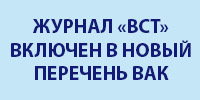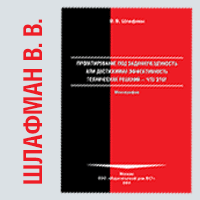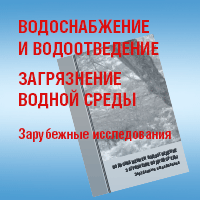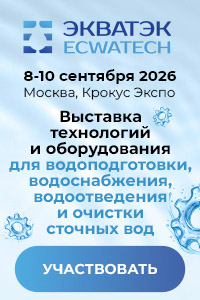№12|2021
ADVANCED TECHNOLOGIES AND EQUIPMENT
DOI 10.35776/VST.2021.12.04
UDC 628.166:541.135
Study of the current waveform effect on the formation of cathode deposits during direct electrolysis
Part 2. Electrolysis of sea water
Summary
Sodium chloride is a raw material for the production of sodium hypochlorite; however, the cost of its purchase and delivery is up to 25–30% of the total cost of the disinfectant produced. An alternative raw material for the production of sodium hypochlorite can be chlorides present in natural mineral water, e. g., underground, sea and oceanic water. Mineral water will be the raw material for obtaining sodium hypochlorite solution of a sufficiently high concentration that can then be added to the treated water. The experience of operating CHLOREFS units manufactured by EKOFES SPE LLC showed that the main problem related to the electrolyzer operation reliability is associated with the formation of deposits of hardness salts – calcium carbonate on the surface of the cathodic electrode, and magnesium hydroxide on the surface of the electrolyzer cathodes. This results in a negative electrolysis regime, an increase in voltage, overheating and warping of the electrode system, destruction of the oxide coating of the anodes, etc. The results of studies of direct electrolysis by direct and reverse current of salt water of the South Vietnam Sea are presented. During the tests the effect of reverse current in comparison with direct current on the reduction of the formation of insoluble substances on the cathodes of the electrolyzer was estimated, and besides, the electrolysis process parameters were determined. The current chlorine yield for seawater was above 100% in the reverse mode with a current density of 100 A/m2.
Key words
disinfection , water treatment , sea water , sodium hypochlorite , direct electrolysis with constant and reverse current
The further text is accessible on a paid subscription.
For authorisation enter the login/password.
Or subscribe
Список цитируемой литературы
- Walles & Tiernan website. Electrolytic chlorination system. Available at: http://www.evoqua.com/en/brands/Wallace_and_Tiernan/Pages/Hypochlorite-Generation-Equipment.aspx/ (accessed 1.12.2021).
- Sistemy OSEC® dlia proizvodstva nizkokontsentrirovannogo gipokhlorita natriia [OSEC® systems for the production of low concentrated sodium hypochlorite]. Available at: http://www.ecocontrol.ru/clauses/stati-pro-obezzarazhivanie-vody/sistemy-osec-dlya-proizvodstva-nizkokontsentrirova/ (accessed 1.12.2021). (In Russian).
- SCITEC NT-H Series website. Electro-chlorination from seawater. Available at: http://en.cnsciyee.com/djhss/html/?22.html/ (accessed 1.12.2021).
- Fesenko L. N., Ignatenko S. I., Pchel’nikov I. V., Terikov A. S. [Units for the production of sodium hypochlorite by sea water electrolysis]. Vodoochistka. Vodopodgotovka. Vodosnabzhenie, 2017, no. 7 (115), pp. 30–35. (In Russian).
- Pchel’nikov I. V. Sovershernstvovanie tekhnologii proizvodstva obezzarazhivaiushchego reagenta – gipokhlorita natriia elektrolizom morskoi vody (na primere Chernogo moria) [Improvement of the technology for the production of a disinfecting agent – sodium hypochlorite by electrolysis of sea water (through the example of the Black Sea). Synopsis of a thesis for Ph. D. degree in Engineering. Novocherkassk, 2014, 155 p.].
- Pchel’nikov I. V., Nguen T. T. Z., Fesenko L. N. [Study of the current waveform effect on the formation of cathode deposits during direct electrolysis. Part 1. Electrolysis of fresh water]. Vodosnabzhenie i Sanitarnaia Tekhnika, 2021, no. 10, pp. 46–51. (In Russian).
- Fesenko L. N., Skriabin L. N., Ignatenko S. I. [Experience in the use of sodium hypochlorite for water disinfection at the treatment facilities of Central Water Supply System of the city of Rostov-on-Don]. Vodosnabzhenie i Sanitarnaia Tekhnika, 2009, no. 9, pp. 46–51. (In Russian).
- Medrish G. L., Teisheva A. A., Basin D. L. Obezzarazhivanie prirodnykh i stochnykh vod s ispol’zovaniem elektroliza [Disinfection of natural and waste water with the use of electrolysis. Moscow, Stroiizdat Publ., 1982, 81 p.].
- Razina N. F. Okisnye elektrody v vodnykh rastvorakh [Oxide electrodes in aqueous solutions. Alma-Ata, Nauka Publ. of the Kazakh SSR, 1982, 161 p.].






